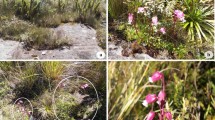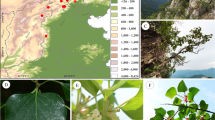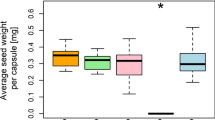Abstract
Many rare plants exist in a naturally fragmented distribution and are expected to exhibit reproductive adaptations to isolation. Thus, understanding the reproduction of these plants might be important in predicting the future of artificially fragmented species. Ameroglossum pernambucense is a threatened ornithophilous shrub with naturally fragmented populations on granite outcrops in north-eastern Brazil. The current research studied two populations of A. pernambucense and determined if three reproductive features (mating system, flowering phenology and nectar dynamics) facilitate the colonisation of new areas and the gene flow among the outcrops. To verify the species’ reproductive efficiency, pollinator efficiency and pollen limitation were tested. Ameroglossum pernambucense has a mixed mating system, and pollinators increased seed production. The pollinator efficiency test revealed that hummingbirds can supply the entire pollen demand. No pollen limitation was detected. Variation in sunset time was the main factor to explain the flowering pattern of A. pernambucense. Nectar was abundantly produced after successive removals. The reproductive traits observed in A. pernambucense were interpreted as highly adapted to its fragmented condition. Phenological photoperiodic regulation may increase the flowering synchrony and chances of gene flow among outcrops in environmentally distinct microsites. The mixed mating system favours both the colonisation of isolated outcrops and allogamy. High flower production and its high energetic value may have an important role in pollinator attraction and may increase long-distance outcrossing. Our data suggest that artificially fragmented plants with reproductive features similar to those observed here might be reproductively less susceptible to fragmentation.




Similar content being viewed by others
References
Aguilar R, Ashworth L, Galetto L, Aizen MA (2006) Plant reproductive susceptibility to habitat fragmentation: review and synthesis through a meta-analysis. Ecol Lett 9:968–980
Andrade-Lima D (1960) Estudos fitogeográficos de Pernambuco. Arq IPA 5:305–341
Augspurger CK (1983) Phenology, flowering synchrony, and fruit set of six Neotropical shrubs. Biotropica 15:257–267
Baker HG (1955) Self-compatibility and establishment after “long distance” dispersal. Evolution 9:347–349
Becker T, Voss N, Durka W (2011) Pollen limitation and inbreeding depression in an ‘old rare’ bumblebee-pollinated grassland herb. Plant Biol 13:857–864
Biodiversitas Foundation (2005) Lista da flora brasileira ameaçada de extinção segundo avaliação no Worshop da Fundação Biodiversitas 2005
Borchert R, Renner SS, Calle Z, Navarrete D, Tye A, Gautier L, Spichiger R, Hildebrand P (2005) Photoperiodic induction of synchronous flowering near the Equator. Nature 433:627–629
Carpenter FL (1983) Pollination energetics in avian communities: simple concepts and complex realities. In: Jones CE, Little RJ (eds) Handbook of experimental pollination biology. Scientific and Academic Editions, New York, pp 215–234
Corrêa ACB, Tavares BAC, Monteiro KA, Cavalcanti LCS, Lira DR (2010) Megageomorfologia e morfoestrutura do Planalto da Borborema. Ver Inst Geo 31:35–52
Dafni A, Kevan PG, Husband BC (2005) Pratical pollination biology. Enviroquest Ltd., Cambridge
Ellstrand NC, Elam DR (1993) Population genetic consequences of small population size: implications for plant conservation. Annu Rev Ecol Syst 24:217–242
Faegri K, Pijl L (1979) The principles of pollination ecology. Pergamin Press, London, p 244
Feinsinger P (1976) Organization of a tropical guild of nectarivorous birds. Ecol Monogr 46:257–291
Feinsinger P, Colwell RK (1978) Community organization among Neotropical nectar-feeding birds. Am Zool 18:779–795
Fischer E, Vogel S, Lopes AV (1999) Ameroglossum, a new monotypic genus of Scrophulariaceae-Scrophularioideae from Brazil. Feddes Repert 110:529–534
Freitas L, Bolmgren K (2008) Synchrony is more than overlap: measuring phonological synchronization considering time length and intensity. Rev Bras de Bot 31:721–724
Freitas L, Sazima M (2001) Nectar features in Estherhazya macrodonta, a hummingbird pollinated Scrophulariaceae in Southeastern Brazil. J Plant Res 114:187–191
Galetto L, Bernardello G (2005) Rewards in flower—nectar. In: Dafni A, Kevan PG, Husband BC (eds) Pratical pollination biology. Enviroquest Ltd., Cambridge, pp 261–313
Ghazoul J (2005) Pollen and seed dispersal among dispersed plants. Biol Rev 80:413–443
Goodwillie C, Kalisz S, Eckert CG (2005) The evolutionary enigma of mixed mating system in plants: occurrence, theoretical explanations, and empirical evidence. Annu Rev Ecol Evol Syst 36:47–79
Günter S, Stimm B, Cabrera M, Diaz ML, Lojan M, Odoñez E, Richter M, Weber M (2008) Tree phenology in montane forests of southern Ecuador can be explained by precipitation, radiation and photoperiodic control. J Trop Ecol 24:247–248
IUCN (2001) IUCN red list categories and criteria: version 3.1. IUCN Species Survival Commission. IUCN Gland, Cambridge, p 30
Justino DG, Maruyama PK, Oliveira PE (2012) Floral resource availability and hummingbird territorial behaviour on a Neotropical savanna shrub. J Ornithol 153:189–197
Kalisz S, Vogler DW, Hanley KM (2004) Context dependent autonomous self-fertilization yields reproductive assurance and mixed mating. Nature 430:884–887
Kameyama Y, Kudo G (2009) Flowering phenology influences seed production and outcrossing rates in populations of an alpine snowed shrub, Phyllodoce aleutica: effects of pollinators and self-incompatibility. Ann Bot 103:1385–1394
Klinkhamer PGL, van der Lugt PP (2004) Pollinator service only depends on nectar production rates in sparse populations. Oecologia 140:491–494
Lehner PN (1979) Handbook of ethological methods. Garland STPM Press, New York, p 510
Leiss KA, Klinkhamer PGL (2005) Spatial distribution of nectar production in a natural Echium vulgare population: implications for pollinator behavior. Basic Appl Ecol 6:317–324
Mavraganis K, Eckert CG (2001) Effects of population size and isolation on reproductive output in Aquilegia canadensis (Ranunculaceae). Oikos 95:300–310
Parmentier I, Oumarou M, Pauwels L, Lejoly J (2006) Comparison of the ecology and distribution of the Poaceae flora on inselbergs embedded in savannah (Benin) or in rain forest (Western Central Africa). Belg J Bot 139:65–77
Porembski S (2007) Tropical inselbergs: habitats types, adaptive strategies and diversity patterns. Rev Bras Bot 30:579–586
Radford AE, Dickinson WC, Massey JR, Bell CR (1974) Vascular plant systematics. Harper and Row Publishers, New York
Reis AC (1976) Clima da Caatinga. An Acad Bras Cienc 48:325–335
Rivera G, Borchert R (2001) Induction of flowering in tropical trees by a 30-min reduction in photoperiod: evidence from field observations and herbarium specimens. Tree Physiol 21:201–212
Seghieri J, Carreau J, Boulain N, Rosnay P, Arjounin M, Timouk F (2012) Is water availability really the main environmental factor controlling the phenology of woody vegetation in the central Sahel? Plant Ecol 213:861–870
Wolowsky M, Saad SF, Ashman TL, Freitas L (2013) Predominance of self-compatibility in hummingbird-pollinated plants in the Neotropics. Naturwissenschaften 100:69–79
Wyatt R (1984) The evolution of self-pollination in granite outcrop species of Arenaria (Caryophyllaceae). I. Morphological correlates. Evolution 8:804–816
Yeang HY (2007) Synchronous flowering of the rubber tree (Hevea brasiliensis) induced by high solar radiation intensity. New Phytol 175:283–289
Young AG, Clarke GM (2000) Genetics, demography and viability of fragmented populations. Cambridge University Press, Cambridge
Zar JH (1996) Biostatistical analysis, 3rd edn. Prentice-Hall International Editions, New Jersey
Acknowledgments
The authors are thankful to the Dr. Marcelo Sobral-Leite, for fruitful discussions, helping during field work and valuable suggestions; Dr. Oswaldo Cruz-Neto, for helping with the field analysis of nectar, Mr. Luís, Mr. José and Ms. Maria for kindly permitting research in their private properties, and Yuri Spetch and M.Scs. Weber Girão, for helping with statistical analyses and hummingbird identifications, respectively. The authors are also grateful to the Fundação de Amparo à Ciência e Tecnologia do Estado de Pernambuco (FACEPE) for providing a master fellowship to the first author and for additional financial support (APQ–1096–2.03/08), and to the Conselho Nacional de Desenvolvimento Científico e Tecnológico (CNPq) for research grants to AVL and ICM.
Author information
Authors and Affiliations
Corresponding author
Rights and permissions
About this article
Cite this article
Wanderley, A.M., Lopes, A.V. & Machado, I.C. Reproductive ecology of Ameroglossum pernambucense (Scrophulariaceae): is this ornithophilous and threatened shrub highly adapted to a naturally fragmented habitat?. Plant Syst Evol 300, 1099–1110 (2014). https://doi.org/10.1007/s00606-013-0948-x
Received:
Accepted:
Published:
Issue Date:
DOI: https://doi.org/10.1007/s00606-013-0948-x




